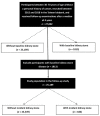Dyslipidemia Increases the Risk of Incident Kidney Stone Disease in a Large Taiwanese Population Follow-Up Study
- PMID: 35405952
- PMCID: PMC9000795
- DOI: 10.3390/nu14071339
Dyslipidemia Increases the Risk of Incident Kidney Stone Disease in a Large Taiwanese Population Follow-Up Study
Abstract
The prevalence and incidence rates of kidney stone disease (KSD) in Taiwan are high; however, the association between lipid profile and KSD has yet to be investigated. The aim of this longitudinal study was to investigate the association between lipid profile with baseline and incident KSD in a large Taiwanese cohort. A total of 27,002 people enrolled in the Taiwan Biobank (TWB) were followed for a median of 4 years and classified into two groups according to whether they had (n = 1813; 6.7%) or did not have (n = 25,189; 93.3%) KSD at baseline. The presence of KSD was defined according to a self-reported history of kidney stones. The participants with baseline KSD (n = 1813) were excluded from the follow-up study, and the remaining participants were classified into two groups consisting of those who had (n = 640; 2.5%) or did not have (n = 24,549; 97.5%) incident KSD. After multivariable analysis, compared to quartile 1 of lipid profile, the participants in quartile 4 of triglycerides, quartiles 3 and 4 of high-density lipoprotein cholesterol (HDL-C), and quartile 4 of total cholesterol (Chol)/HDL-C ratio were significantly associated with baseline KSD. In the follow-up study, the participants in quartiles 2, 3, and 4 of triglycerides; quartile 2 of Chol; quartile 4 of HDL-C; quartile 3 of LDL-C; and quartiles 3 and 4 of Chol/HDL-C ratio were significantly associated with incident KSD. Our results showed that hypertriglyceridemia (67−93 mg/dL) was associated with a 1.463-fold increased risk of incident KSD and that low HDL-C (>63 mg/dL) protected against incident KSD formation. In addition, a Chol/HDL-C ratio larger than 3.64 was associated with a 1.381-fold increased risk of incident KSD. Our findings may imply that the optimal management of dyslipidemia may be associated with a lower risk of developing kidney stones.
Keywords: Taiwan Biobank; follow-up; kidney stone disease; lipid profile.
Conflict of interest statement
The authors declare no conflict of interest.
Figures



References
MeSH terms
Substances
LinkOut - more resources
Full Text Sources

